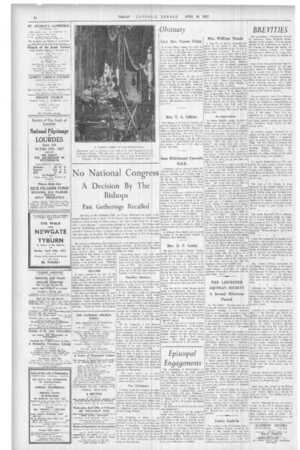Page 14, 16th April 1937
Page 14

Report an error
Noticed an error on this page?If you've noticed an error in this article please click here to report it.
Tags
Share
Related articles
National Congress To Be Discontinued
Engagements
Benediction In Cup-tie Arena
20,000 Congress Badges Go Out T Hree Months Before The...
Bishops' Engagements
No National Congress
A Decision By The Bishops
Past Gatherings Recalled Speaking in the Cathedral Hall, on Friday afternoon last week, at the annual meeting of the Catholic Truth Society, the Archbishop of Westminster made an announcement of direct concern not only to that body but to many other " extra-diocesan " organizations throughout the country. His Grace said that the Archbishops and Bishops of England and Wales have decided that the periodical National Catholic Congress will not in future be held; the Hierarchy will encourage, in its place, the resumption of the annual C.T.S. Conference, an event which preceded the Congress during many years.
The decision to discontinue the Congress has been arrived at because the bishops feel that the C.T.S. Conference will have more practical effect. This point was emphasised by Mgr. Hinsley in making the announcement. They did not want, his Grace said, merely academic congresses leading to no practical result. Working efforts were wanted. The Catholic Truth Society's Conference should be encouraged.
1910-1929
So ends a chapter in the story of the Church's many activities in this country, which began with the Congress held at Leeds in 1910, and continued at intervals until 1929, when a National Congress at Westminster celebrated at the same time the centenary of Catholic Emancipation.
The war years brought about an intermission in what had been, until then. an annual event since the launching of the first Congress. Leeds was followed in 1911 by another large-scale assembly, at Newcastle on-Tyne. From the North the Congress went, in the next year, to East Anglia, meeting at Norwich. In 1913 there was a move right across to the West Country, Plymouth being the venue.
South Wales had its first and only gathering at Cardiff not long before the outbreak of the war. There was to have been a second Cardiff meeting more re
cently, in 1935. The opening of that year, however, brought Cardinal Bourne's death, and on this and other grounds the holding of the Congress was deferred.
Post-War Meetings
After the war the National Congress was resumed, though not as an annual event. Liverpool, Birmingham, Manchester: all these in turn were chosen cities.
It was resolved to make the gathering triennial, an arrangement which would have brought 1932 into the scheme. But in 1932 the international Eucharistic Congress was held in Dublin, and the English hierarchy decided, in those circumstances, not to hold a National Congress but to encourage the faithful to participate instead in the great meeting in Ireland. The Westminster Congress of 1929, therefore. as events have now decreed, was the final one.
All the Congresses, in their different ways, were marked by demonstrations largely planned, in which various organisations throughout the country participated. For outstanding size and enthusiasm, the last of them all, in the Emancipation centenary year, was the most noteworthy, recalling, as it did in some respects, the scenes witnessed in the same localities for the great Eucharistic Congress of 1908.
Three times the Royal Albert Hall was filled, in 1929. at special mass meetings; while for outdoor religious demonstrations London can hardly have seen anything more impressive than the silent march of twenty thousand Catholic men from the Southwark side of the river to the Cathedral precincts at Westminster.
The men's march was a public proclamation of faith which was not lost upon the general population. as many press references testified.
Two Exhibitions
A feature of the first Congress. at Leeds, was an exhibition of antiquities and objects of art illustrative. chiefly, of the penal times. This brought together three hundred exhibits on loan from colleges, abbeys, and private owners in many parts of the country. At Birmingham, Bingley Hall housed an exhibition largely devoted to the work of the Foreign Missions.
FOR SEAFARERs IN ROME, — An Apostolato del Mare section has been established by the St. Vincent de Paul Conference, S. Benedetto, at Porto Eluviale, the river port of Rome. This development is one of the fruits of the resolution taken at the Conference recently held in Genoa by the St. Vincent de Paul A.M. Promoters to invite all Port Conferences S.V.P. in I Italy to form sections.
blog comments powered by Disqus

















